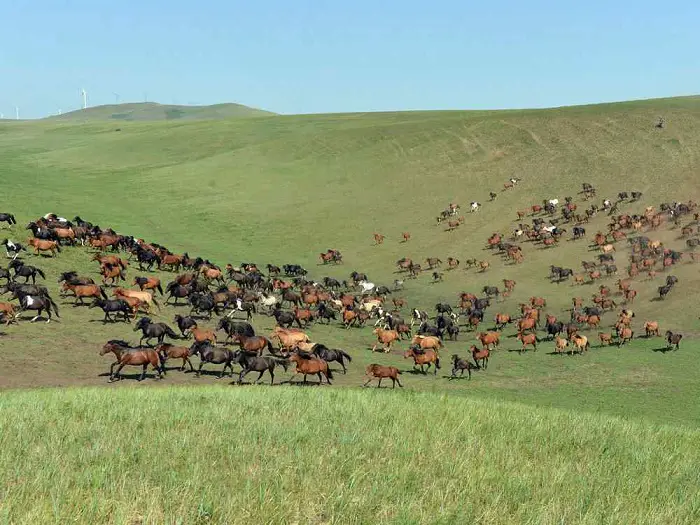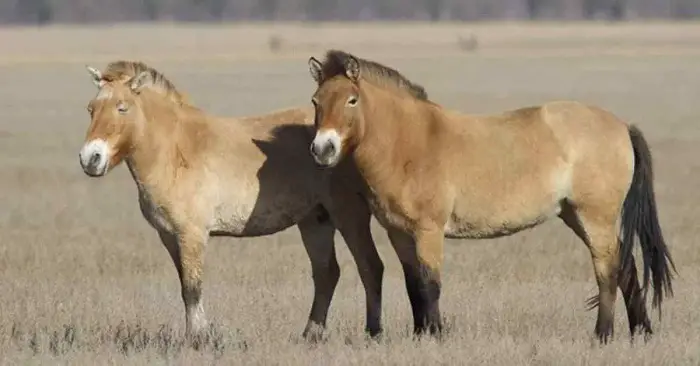Wild horses of Mongolia, known as Przewalski’s horses (Equus ferus przewalskii), are native to the steppes of Central Asia, including Mongolia. These horses are often considered the only valid wild horse species left worldwide. The reintroduction of Przewalski’s horses to Mongolia is considered a significant success story in wildlife conservation. These efforts have helped preserve a unique and critically endangered species and restored a vital part of Mongolia’s natural heritage.
History of Horses in Mongolia
Horses have played a central role in the history and culture of Mongolia for thousands of years. The relationship between Mongolians and horses is deeply intertwined and has profoundly impacted their nomadic way of life, warfare, and cultural traditions. Here is an overview of the history of horses in Mongolia:
- Ancient Domestication: Horses were domesticated in the region now Mongolia around 3500-3000 BC. This early domestication allowed the nomadic people of the area to develop a pastoral way of life based on herding horses, sheep, goats, and other livestock.
- Nomadic Lifestyle: The Mongolian nomads, historically organized into tribes and clans, relied heavily on horses for transportation, food, and daily tasks. Horses were essential to traversing Mongolia’s vast steppes and deserts and moving their dwellings, known as gers or yurts, to new grazing lands.
- Genghis Khan and the Mongol Empire: Perhaps the most famous figure associated with Mongolian horses is Genghis Khan, the founder of the Mongol Empire in the 13th century. Genghis Khan and his successors created one of the largest empires in history, largely thanks to their skilled cavalry. Mongol warriors were renowned for their horsemanship and could conquer vast territories due to their speed and mobility in battle.
- The Mongol Pony: The Mongolian horse, often called the Mongol pony, is a small but hardy breed known for its endurance, strength, and adaptability to harsh environments. These horses have been bred for centuries to withstand Mongolia’s extreme temperatures and rugged terrain.
- Cultural Significance: Horses hold a special place in Mongolian culture and are celebrated in various traditional festivals and sports. The most famous is Naadam, an annual event featuring the “Three Manly Games” of wrestling, archery, and horse racing.
- Horse Racing: Mongolian horse racing is a popular sport with ancient roots. These races can cover long distances, with horses and young jockeys showcasing their riding skills. Mongolia’s most prestigious horse race is the Nadaam Festival’s horse race.
- Preservation Efforts: The Mongolian government and various organizations have worked to preserve the native Mongolian horse breed and its genetic diversity. Efforts have been made to protect and conserve these horses, which are crucial to Mongolia’s nomadic way of life.
- Modern Uses: Today, horses continue to be vital to the livelihoods of many Mongolian herders. They are used for herding livestock, transportation, and cultural events. In recent years, there has also been a growing interest in horseback tourism, allowing visitors to explore Mongolia’s stunning landscapes on horseback.
How many wild horses are in Mongolia?
The population of wild horses in Mongolia may have changed since then. The population of Przewalski’s horses considered the only true wild horse species, has been the subject of conservation efforts in Mongolia, and it has increased over the years due to reintroduction programs.

Conservation organizations and government agencies actively monitor the population of Przewalski’s horses in Mongolia, and the numbers have been gradually growing due to these efforts. To obtain the most current and accurate information regarding the population of wild horses in Mongolia, I recommend checking with organizations involved in wild horse conservation or consulting recent scientific studies and reports on the subject.
Breeds of Wild Horses in Mongolia
Mongolia is home to several breeds of horses, but when people refer to “wild horses” in Mongolia, they typically talk about Przewalski’s horses (Equus ferus przewalskii). These horses are often considered the only valid wild horse species. While Przewalski’s horses are the most famous “wild horses” in Mongolia, it’s important to note that Mongolia also has a rich history of domesticated horse breeds that have been essential to the nomadic way of life. Some notable domesticated horse breeds in Mongolia include:
1. Przewalski’s Horse (Takhi in Mongolian):
-
- Przewalski’s horses are native to the steppes and deserts of Central Asia, including Mongolia.
- They are miniature, stocky horses with a dun coat, a short mane, and a distinctive erect mane.
- Przewalski’s horses are the last surviving wild horse subspecies and are critically endangered.
- Conservation efforts, including reintroduction programs, have been undertaken to restore these horses to their native habitat in Mongolia.
2. Mongolian Horse (Mongol Horse):
-
- The Mongolian horse is a versatile and hardy breed known for its endurance, strength, and adaptability to harsh environments.
- These horses are small in stature but have great stamina, making them well-suited for long journeys across the steppes.
- They come in various coat colors, including bay, gray, chestnut, and black.
- Mongolian horses have played a central role in the Mongolian people’s nomadic culture and way of life.
3. Khustain Nuruu Horse (Takhi):
-
- These horses are a domesticated breed found in the Khustain Nuruu National Park in Mongolia.
- While they share a name with Przewalski’s horses, they are not the same species. Khustain Nuruu horses are domesticated and not considered wild horses.
4. Kazakh Horse (Altai Horse):
-
- Kazakh nomadic communities commonly use Kazakh horses in western Mongolia, particularly in the Altai region.
- These horses are known for their endurance and are often used for herding livestock.
Culture and Traditions of Mongolian Horse
Horses hold a special place in Mongolian culture and have been integral to the nomadic way of life for centuries. The horse is not just a means of transportation or a tool for herding livestock; it symbolizes national identity and an essential part of Mongolian traditions. Here are some aspects of the culture and traditions of the Mongolian horse:
- Nomadic Lifestyle: The Mongolian people have historically been nomadic herders, and horses have been central to their way of life. Horses provided the means for transportation, allowing nomads to move their dwellings (ger or yurt) and herds to new grazing areas.
- Cultural Significance: Horses are highly respected in Mongolian culture. They are considered noble animals and are often called the “five snouts” because they provide the nomadic people with meat, milk, transportation, wool, and leather.
- Horse Festivals: Mongolia hosts various horse-related festivals yearly to celebrate horses’ importance in their culture. The most famous of these festivals is Naadam, which features the “Three Manly Games” of wrestling, archery, and horse racing.
- Horse Racing: Mongolian horse racing is a popular sport with ancient origins. Races can cover long distances, with horses and young jockeys showcasing their riding skills. The Nadaam Festival’s horse race is the most prestigious event, attracting participants and spectators nationwide.
- Horse Archery: Archery is another traditional Mongolian sport that involves shooting arrows from horseback. Competitions showcase the skill and accuracy of riders as they hit targets while riding at full gallop.
- Horse Wrestling: Traditional Mongolian wrestling, known as “Bokh,” is popular during Naadam. Wrestlers wear traditional costumes and aim to throw their opponents to the ground. Horses are often used to parade the victorious wrestlers after matches.
- Horse Herding: Horses are used for herding other livestock, such as cattle, sheep, and goats. Nomadic herders depend on their horses to manage their herds and ensure survival in the harsh Mongolian landscape.
- Horseback Riding: Horseback riding is an ordinary skill among Mongolian nomads, and children often learn to ride at a young age. Horses are also used for hunting and gathering activities.
- Symbolism: Horses are symbols of freedom and independence in Mongolia. They represent the nomadic spirit and resilience of the Mongolian people.
- Conservation: Efforts are made to preserve and protect the native Mongolian horse breed and Przewalski’s horses in the country. Conservation initiatives aim to maintain these horse populations’ genetic diversity and health.
Are Mongolian Horses Rare?
Mongolian horses are not considered rare in Mongolia, where they are a fundamental part of the country’s culture, heritage, and nomadic way of life. These horses have been bred for centuries to thrive in the harsh and variable conditions of the Mongolian steppes and deserts, making them well-suited to the region’s climate and terrain.
While Mongolian horses may not be considered rare within Mongolia, they are a unique and distinct breed known for their endurance, strength, and adaptability. They are small in stature but possess remarkable stamina, which allows them to cover long distances across the vast landscapes of Mongolia.
Mongolian horses are crucial to the daily lives of nomadic herders in Mongolia. They are used for various purposes, including transportation, herding livestock, and participating in traditional sports and festivals. Their role in herding is significant, as they help nomads manage their cattle, sheep, and goats on the open steppes.
Final Talk on Wild Horses in Mongolia
Outside of Mongolia, Mongolian horses are less common and might be considered more unusual or unique due to their specific characteristics and adaptability to a nomadic lifestyle. Efforts are made to preserve the genetic diversity and health of the Mongolian horse breed, both within Mongolia and among breed enthusiasts worldwide. This breed’s resilience and cultural significance contribute to its continued importance in Mongolia and its recognition in other parts of the world.
In summary, Mongolia’s wild horses, particularly Przewalski’s, represent an essential conservation success story. These horses are a testament to the country’s unique natural heritage and a symbol of the enduring connection between the Mongolian people and their horses, which have been essential to their way of life for centuries.

